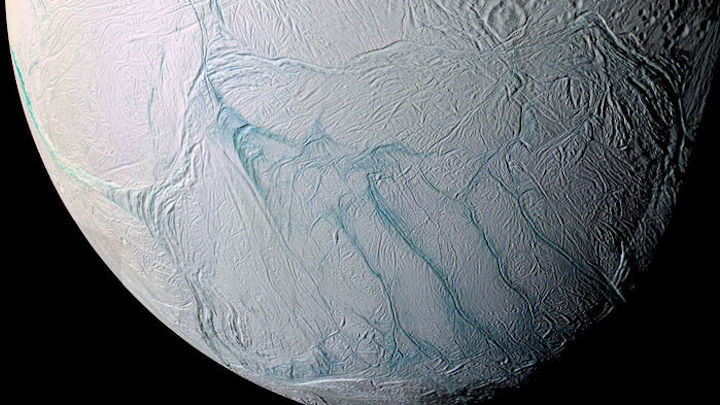15.11.2019

Researchers say they have solved a long-standing mystery about Saturn’s tiny, frozen moon Enceladus: why its south pole features long, water-spewing geysers known as tiger stripes. The study could also help explain why these unique formations aren’t seen on any other satellite in the solar system.
Enceladus became a star attraction in 2005, when NASA’s Cassini mission photographed enormous jets of water ice and vapor emanating from four parallel slashes near its south pole. Since then, researchers have detected organic molecules and hydrogen in the jets—potential food for microbes—making Enceladus one of the top destinations in the search for life elsewhere in the Solar System. The stripes, named Baghdad, Cairo, Damascus, and Alexandria after locations in the One Thousand and One Nights collection of Middle Eastern folktales, are 130 kilometers long and are spaced roughly 35 kilometers apart—rather large features on a moon only 500 kilometers in diameter. Nobody quite understood their origin, or why they were only seen at one pole.
In 2006, planetary scientist Francis Nimmo of the University of California, Santa Cruz, posited that the stripes formed elsewhere on the moon and then migrated to the south pole after a hot spot welled up internally, creating a low-density bubble that knocked the world off kilter. But a paper posted this week on the preprint server arXiv tells a potentially more satisfying creation story.
As it orbits around Saturn, Enceladus experiences gravitational tidal forces that squeeze and heat it. Cassini data had already shown that a liquid water ocean sits underneath the outer ice shell, which is thinnest at the north and south poles. According to the new study, led by Douglas Hemingway of the Carnegie Institution for Science in Washington, D.C., as the moon cooled over time and some of the ocean water refroze, the new ice generated strain that built up in the surface until it broke. “It’s like your pipes freezing on a cold day,” says Nimmo, who was not involved in the study.
The thin polar ice was the most likely place for a crack to form, though it seems to be a matter of chance whether the first stripe burst into being at the north or south pole. But according to the study, once one large fracture appeared, the ice pressure was relieved, suppressing the creation of another furrow on the opposing pole.
That first fissure, extending down to the ocean, allowed a geyser to spray snow on its two flanks. The weight of this extra material produced more strains. In their study, the researchers calculate that these forces should have cracked additional grooves on either side, roughly 35 kilometers from the original one.
Future investigations could shore up the new theory by determining whether the central stripes are the progenitors, older than the outer ones. But the model seems to do a good job of explaining the grooves’ location and spacing, Nimmo says. The new theory “is very probably right,” he adds. “It’s pretty simple, and they explain several things that we just didn’t have a good explanation for before.”
Enceladus is the sole known possessor of tiger stripes (although controversial evidence suggests Jupiter’s moon Europa sports similar watery spouts). Its small size might explain why. The moon’s low gravity means that fractures can bust all the way through its outer shell and persist. On a more massive moon, the researchers say in their study, the weight of heavier ice would tend to squeeze cracks shut.
This explanatory power is “one of the nice things” about the new idea, Nimmo says. “There’s something special on Enceladus.”
Quelle: AAAS
